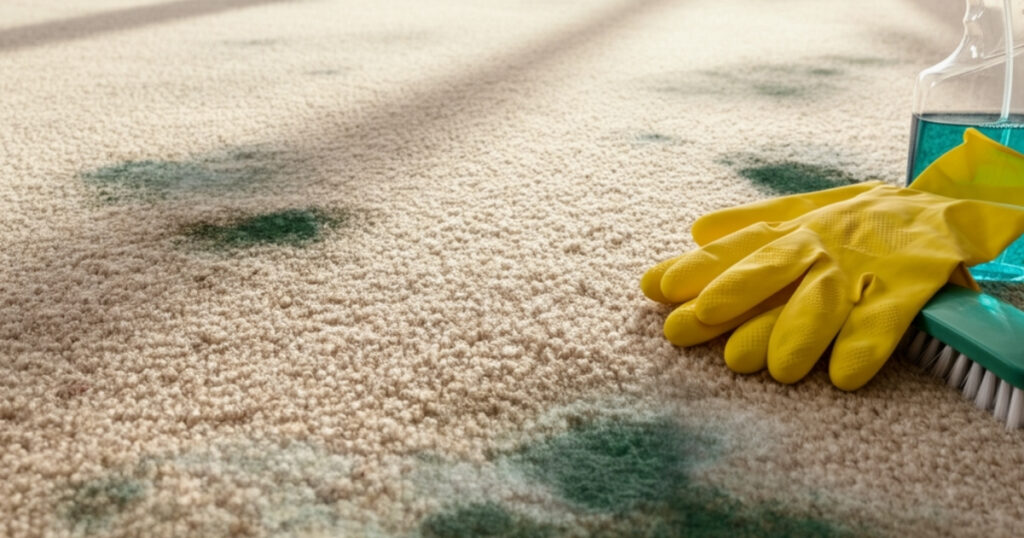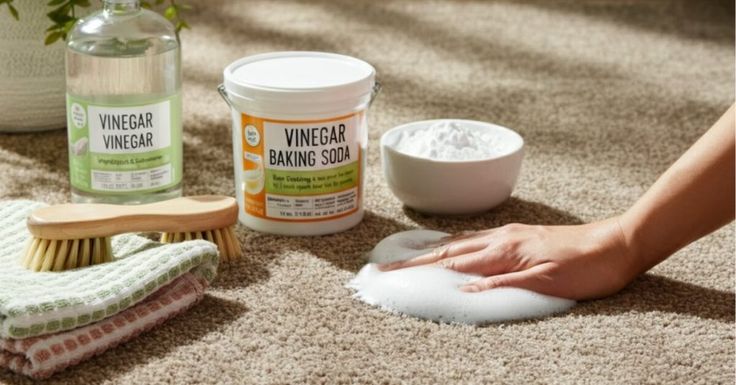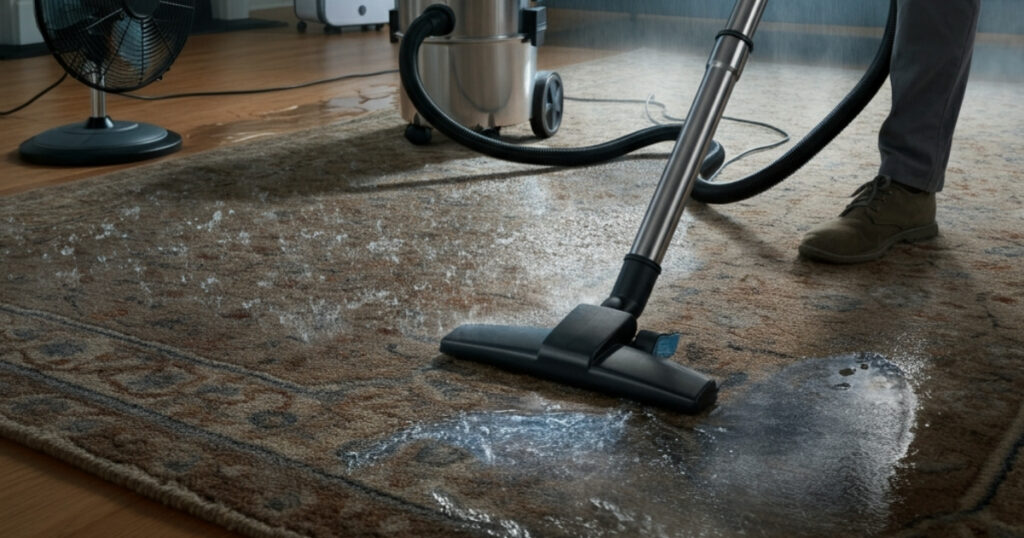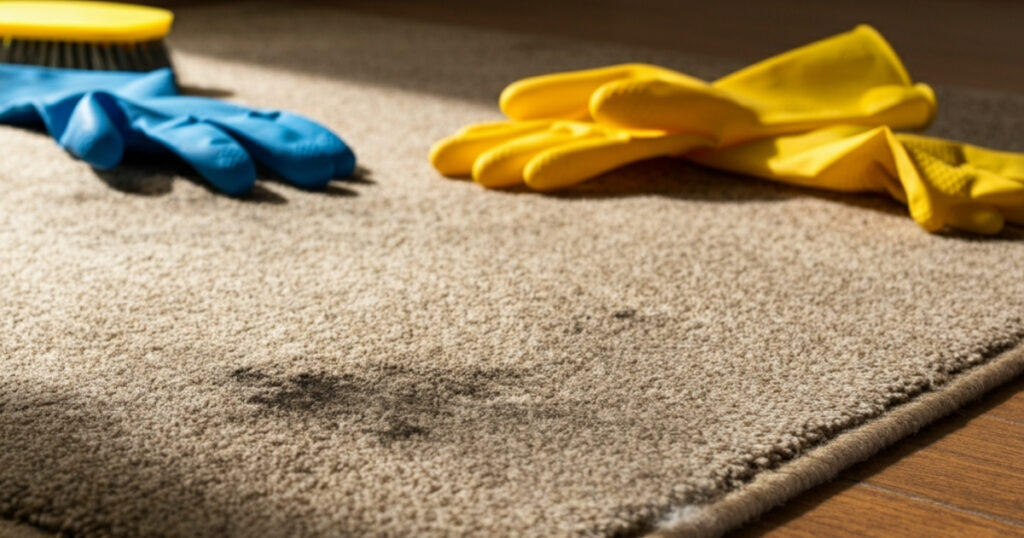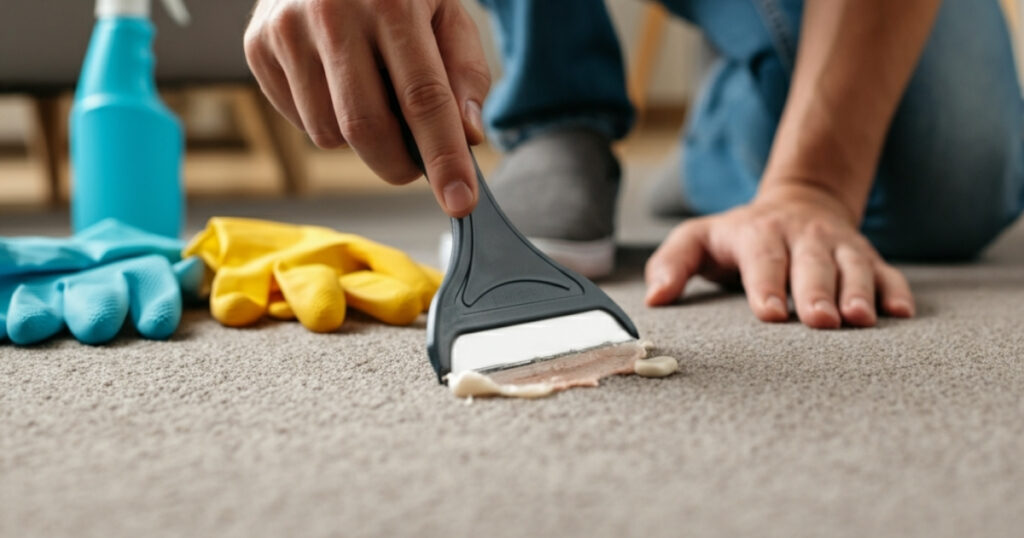As an Amazon Associate, I earn from qualifying purchases.
Finding mould on your carpet can be alarming. It’s an unwelcome discovery that often brings concerns about health, appearance, and the potential for long-term damage. The good news is that if you act quickly, you can learn how to remove mould from carpet yourself. This guide provides a detailed, step-by-step process for tackling mould, helping you restore your carpet and protect your home.
This article will walk you through everything you need to know about getting rid of carpet mould. We’ll cover how to identify it, the supplies you’ll need, and the specific actions to take for both small and large infestations. Furthermore, we’ll share effective prevention strategies to keep mould from coming back. By following these instructions, you can handle the problem efficiently and keep your living space clean and healthy.
Contents Overview
Understanding and Identifying Carpet Mould
Before you can remove mould, you need to be sure that’s what you’re dealing with. Mould is a type of fungus that grows in damp, humid environments. On carpets, it can appear in various forms, and early identification is crucial for effective removal.
What Does Mould on a Carpet Look Like?
Mould on a carpet often starts as small, discolored spots that can be easy to overlook. As it grows, it becomes more noticeable. Here’s what to look for:
- Discoloration: Mould can appear as black, green, white, or even pink patches on your carpet fibers. These spots may look fuzzy or slimy.
- Musty Odor: A persistent, damp, and earthy smell is one of the most common signs of mould growth, even if you can’t see it. This odor is caused by microbial volatile organic compounds (MVOCs) released by the mould.
- Dampness: Mould thrives in moisture. If an area of your carpet feels perpetually damp, it’s a prime location for mould growth.
Common Causes of Carpet Mould
Understanding the root cause is essential for preventing future outbreaks. Mould needs moisture, a food source (like carpet fibers and dirt), and warmth to grow. Common causes include:
- Spills and Stains: Liquid spills that aren’t cleaned and dried properly can seep into the carpet padding, creating a breeding ground for mould.
- High Humidity: Homes in humid climates or areas with poor ventilation, like basements and bathrooms, are more susceptible to mould.
- Leaks: Leaks from pipes, roofs, or windows can saturate carpets and lead to significant mould problems if not addressed quickly.
- Flooding: Even minor flooding can cause extensive mould growth if the carpet and subfloor are not thoroughly dried within 24-48 hours.
Preparing to Remove Mould from Your Carpet
Safety should be your top priority when dealing with mould. Before you start the cleaning process, gather the right protective gear and cleaning supplies to do the job safely and effectively.
Safety First: Essential Protective Gear
Mould spores can be harmful when inhaled, and some cleaning agents can irritate the skin. Protect yourself with the following equipment:
- N-95 Respirator Mask: To prevent inhaling mould spores.
- Goggles: To protect your eyes from spores and cleaning solutions.
- Rubber Gloves: To protect your hands from chemicals and direct contact with mould.
- Long-Sleeved Clothing: To protect your skin.
Necessary Tools and Cleaning Solutions
Having everything on hand before you begin will make the process smoother. You’ll need:
- Stiff-Bristled Brush: For scrubbing the mould from carpet fibers.
- Spray Bottles: For applying cleaning solutions.
- Dry Cloths or Paper Towels: For blotting the area.
- Wet/Dry Vacuum or Carpet Cleaner: For extracting moisture and cleaning solution.
- Baking Soda: To absorb moisture and deodorize.
- White Vinegar: A natural anti-fungal agent.
- Hydrogen Peroxide (3% solution): Effective for killing mould, but can lighten some carpet colors (test first).
- Commercial Mould Remover: Specifically designed for carpets.
- Dehumidifier and Fans: To help dry the area completely after cleaning.
A Step-by-Step Guide on How to Remove Mould from Carpet
Now that you’re prepared, it’s time to tackle the mould. The method you use will depend on the size of the affected area.
Step 1: Ventilate the Area
First, open windows and doors to ensure good airflow. This helps to dissipate mould spores and fumes from cleaning solutions. If possible, use fans to direct air out of the room.
Step 2: Stop the Moisture Source
Identify and fix the source of the moisture. Whether it’s a leak, a spill, or high humidity, you must resolve this issue to prevent the mould from returning.
Step 3: Dry the Carpet Thoroughly
If the carpet is still damp, you need to dry it completely. Use a wet/dry vacuum to extract as much water as possible. For smaller damp spots, press down firmly with dry towels. Follow up with fans or a dehumidifier to ensure the carpet and padding are bone dry. This step is critical, as cleaning a wet carpet will be ineffective.
Step 4: Choose and Apply Your Cleaning Solution
For small mould spots, natural solutions can be very effective. For larger, more stubborn areas, you might need a stronger commercial product.
For Minor Mould Spots (Natural Method):
- Create a Vinegar Solution: Mix equal parts of white vinegar and water in a spray bottle. Vinegar is a mild acid that can kill many types of mould.
- Spray the Area: Lightly spray the mouldy patch with the vinegar solution. Avoid oversaturating the carpet, as excess moisture can worsen the problem.
- Let It Sit: Allow the solution to sit for about an hour. This gives the vinegar time to penetrate and kill the mould.
- Scrub and Blot: Use a stiff-bristled brush to gently scrub the mouldy fibers. Then, blot the area with a clean, dry cloth to absorb the loosened mould and moisture.
- Rinse Lightly: Spray the area with a small amount of clean water and blot again to rinse out the vinegar.
- Apply Baking Soda: Sprinkle a generous amount of baking soda over the cleaned area. Baking soda will absorb any remaining moisture and help eliminate odors. Let it sit overnight.
For Stubborn Mould Stains (Stronger Method):
- Use Hydrogen Peroxide: For tougher stains, a 3% hydrogen peroxide solution can work well. Important: Test it on a hidden spot of your carpet first to ensure it doesn’t cause discoloration. Apply it lightly, let it sit for 15-20 minutes, then scrub and blot as you would with vinegar.
- Try a Commercial Cleaner: If natural methods don’t work, use a carpet cleaner specifically formulated to remove mould and mildew. Follow the manufacturer’s instructions carefully for application and safety.
Step 5: Vacuum the Area
The next day, use a vacuum cleaner to thoroughly remove all the dried baking soda. Make sure your vacuum has a HEPA filter to capture any remaining mould spores.
Step 6: Final Drying Process
Ensure the carpet is 100% dry. Use fans and a dehumidifier for at least 24 hours after cleaning to remove all traces of moisture from the carpet fibers and padding. This final drying step is crucial to prevent the mould from growing back.
When Should You Call a Professional?
While DIY methods are effective for small areas, some situations require professional help. Consider calling a professional mould remediation service if:
- The mould covers a large area (more than 10 square feet).
- The mould has penetrated deep into the carpet padding or subfloor.
- You or someone in your household has a respiratory condition or a compromised immune system.
- The mould returns after you’ve cleaned it.
- The mould is the result of sewage or contaminated water.
Professionals have specialized equipment and knowledge to safely and completely remove large-scale mould infestations and address the underlying moisture problems.
Your Path to a Mould-Free Home
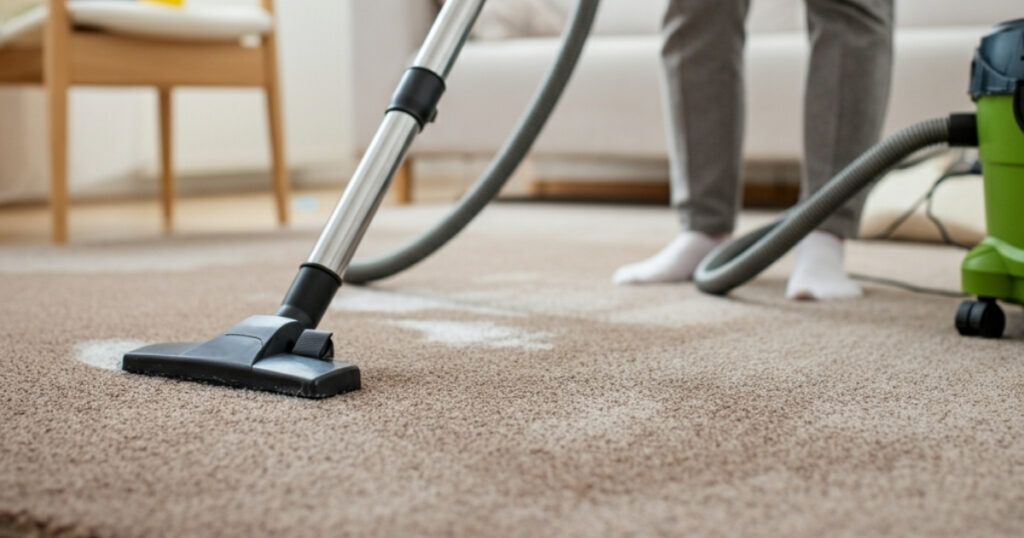
Learning how to remove mould from carpet is a valuable skill for any homeowner. By acting quickly and following these steps, you can eliminate mould, protect your carpet, and maintain a healthier living environment. The key is to address the moisture source and ensure the area is completely dry after cleaning. With the right approach, you can confidently handle mould and keep your carpets looking and feeling fresh.
Frequently Asked Questions
1. Can I use bleach to kill mould on my carpet?
No, it is not recommended. Bleach can damage and discolor carpet fibers. Moreover, it is often not effective at killing mould on porous surfaces like carpets, as the mould can grow back from its roots.
2. Will mould in my carpet go away on its own?
No, mould will not go away on its own. It will continue to grow and spread as long as it has moisture and a food source. It must be actively removed.
3. Is it safe to vacuum mould on a carpet?
No, do not vacuum visible mould directly, as this can spread the spores into the air. You should only vacuum the area after you have treated it with a cleaning solution and covered it with baking soda that has dried completely. Use a vacuum with a HEPA filter for this.
4. How quickly does mould grow on a wet carpet?
Mould can begin to grow on a wet carpet within 24 to 48 hours. This is why it is so important to dry any spills or water damage as quickly as possible.
5. Can I save a carpet that has been completely soaked in a flood?
It depends. If the carpet has been saturated for more than 48 hours, especially with contaminated water, it is often best to replace it. Extensive water damage makes complete mould removal very difficult, and the carpet padding is likely ruined.
As an Amazon Associate, I earn from qualifying purchases.

